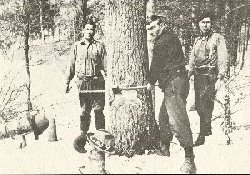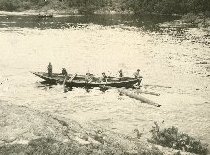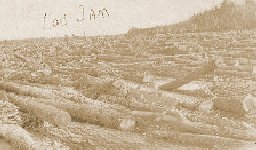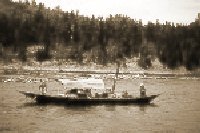|
Back to History of Logging
Glossary Life in the Lumber Camps Logging in the Mississagi River Valley Logging in Northern Ontario |
Tools and Techniques
The first task for a lumber company - after the timber limits had been obtained - was to build the lumber camp. This was usually done in early autumn, to provide lodging for the men and horses. The lumberjacks then moved in with axes and crosscut saws, and began to fell trees. Each tree had to be at least 9 inches in diameter to be deemed appropriate for use as lumber. Once the trees were down, the part of the tree that would become timber was marked - usually eight to twenty-four feet in length - and the Rosser took a piece of bark from each angled face. The Liner would put a long line stretched across the rossed part. At one end of the line was a hook, and at the other was the Faller who would keep the line taut. When the line was tight, the Liner would snap it like an elastic, making a line across the length of the log. Then the Scorer would chop the timber with his axe, at intervals of around 10 inches, and the Hewer would make the timber smooth from end to end. Cutting from dawn to dusk, a crew could average at least 100 logs a day.
After the cutting crews came the Swampers, who cleared trails for the Skidders. Next were the Skidders, who brought the logs out over these trails with horses, to the skidways built along the branch roads. These skidways, which could be from one tier to ten feet high, kept the logs clear of the ground until the sleigh haul. While the cutting and skidding was going on, crews were also building the branch and main roads in preparation for the sleigh haul, which began once the snow came. For the sleigh haul, the roads were rolled, levelled and iced, making it easier for the teams and sleighs which would haul the logs. Large loads or extra-icy roadways could provide serious problems for the men when taking sleighs downhill, so a machine called a crazy-wheel was often used in these dangerous conditions. 
The crazy-wheel was attached to the sleighs by large cables, and would remain at the top of the hill, slowing the sleighs as the horses took the loads down the hills. Loads were built with decking lines and cant hooks in the early days, but after the turn of the century jammers began to take the place of the decking lines. Below:A Jammer is Used to Load a Sleigh 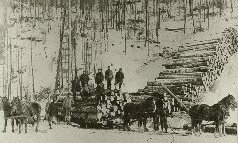
The sleigh haul ran through January and February, when drivers would work even into the night to get the logs hauled to the river dump. At the river dump logjams often occured, although they were not as frequent or as dangerous as those which occurred in the water. Bulldozers were often used to break up logjams on land. After the spring breakup in April, the river drive began. The 'river hogs', wearing calked boots and carrying peaveys, would drive the logs down the river to the mills. Men doing this job required good balance, agility and steady nerves. They had to be very careful not to damage the logs in any way. Bridges and sharp bends in the river were patrolled, anywhere where a logjam could occur. There were many ways that a logjam could be broken up. Sometimes men would approach the jams in boats called pointers, using cant-hooks and peaveys to work at the logs until they separated.
As jams could break quickly, breaking the jams was dangerous work because drivers would often have little time to get to shore after a jam broke. Dynamite was used as a last resort, as it could damage good logs. River drives ran on the Mississagi River and its tributaries, the Aubinidong, Wenebegon, and Little White, until the 1960's. When the river drives were going on, whole camps would have to move with the logs. The cook would load his equipment into one fairly large boat, and that would be where the food was cooked while the river drive was taking place.
Somewhere along the river drive the logs would have to go through a Sorting Jack. A Sorting Jack was made up of sidewalk-like pieces of wood which were attached to pilings on the banks of the river. Representatives of each logging firm using that river for drives would stand on these 'sidewalks'. When logs with their company's mark would come along, the men would make sure that the logs were directed to the correct receiving gap. Over the years of the logging industry, there were around 27 companies using the North Channel (which included the Mississagi River and its tributaries) to transport their logs. Thirteen of these companies had at least two marks which signified that company. At one point there were 12 companies, and at least 29 marks being used at the same time. You have to wonder just how the men managed to remember which marks belonged to which companies.
|
Home | Natural Environment | History | Industry | Personalities/Stories | Credits/Team
